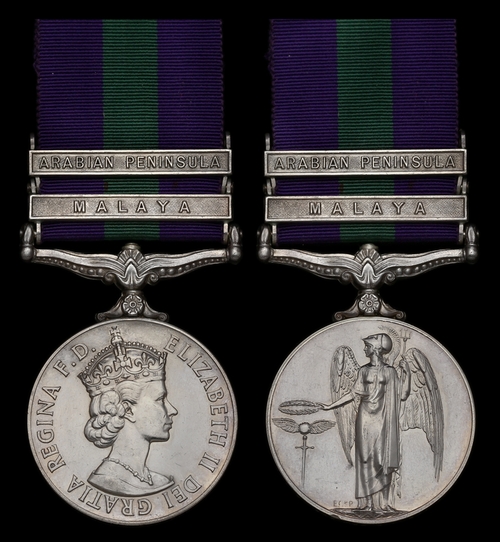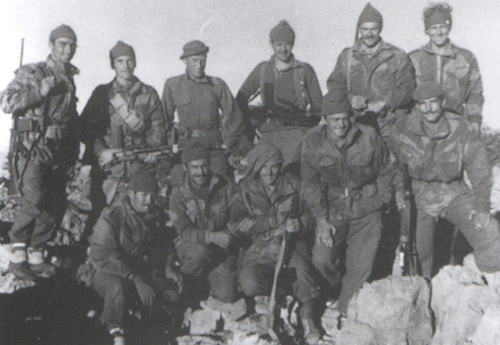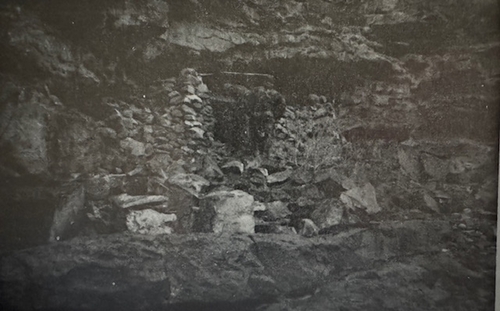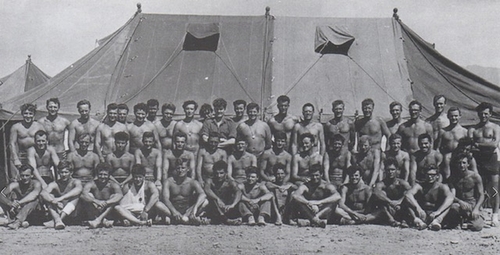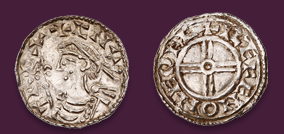Auction: 25002 - Orders, Decorations and Medals
Lot: 26
The General Service Medal awarded to Trooper J. D. Edwards, Special Air Service
General Service 1918-62, 2 clasps, Malaya, Arabian Peninsula (22806846 Tpr. J. D. Edwards. S.A.S.), rod between first and second clasp, good very fine
J. D. Edwards served with 'D' Squadron, 22 Special Air Service and began his active service in Malaya, where he was involved in multiple operations - a campaign that shaped early post-war British special operations doctrine. He participated in numerous long-range jungle patrols, often inserted by helicopters. These missions employed an early and risky technique the SAS called “tree-hopping” - low-level insertion drops into dense jungle intended to surprise enemy units and bypass conventional landing zones. Edwards’ experience in Malaya would directly inform the way he operated in later campaigns, particularly in Oman.
By 1958, the Sultan of Oman faced a growing insurgency in the Jebel Akhdar the Green Mountain a natural fortress in the interior of the country, where dissident forces backed by Nasser’s Egypt had entrenched themselves. British conventional forces had little success in pushing them out. The terrain steep, rocky, and remote was ideal for guerrilla resistance and nearly impossible to clear with standard military tactics. The SAS was called in to do what regular units couldn’t.
A and D Squadrons 22 SAS, including 16 and 17 Troops, were tasked with a straightforward mission: break the insurgency in the Green Mountain and reassert the Sultan’s control. The methods were anything but simple. They involved reconnaissance behind enemy lines, infiltration of cave systems and ridgelines, and direct-action raids on well-defended insurgent positions. Operators like Edwards were already used to working in isolation, gathering intelligence under threat of discovery, and navigating unforgiving terrain. That skill set translated directly into the Jebel Akhdar campaign.
He was involved in numerous deep reconnaissance patrols ahead of larger actions, many of which informed the eventual full-scale assault in early 1959. He worked in a small team, often with minimal support, operating in total silence to identify enemy firing positions, supply caches, and movement corridors. His prior experience in Malaya moving undetected through hostile environments served him well in the rocky escarpments and wadis of Oman. The recipient also took part in sabotage operations, targeting supply routes and storage points to destabilise the rebels’ logistics. Whilst in the field, Edwards worked alongside Lieutenant Peter de la Billière, winning his first Military Cross in the process. That Lieutenant went on to become the Commanding Officer of 22 SAS, and was a respected and experienced operator, involved in planning and execution of several successful raids, particularly those aimed at destabilising key insurgent positions. He of course went on to become a full General, with two K's, a D.S.O. and a Bar to his M.C.
Edwards worked closely with Trooper Scouse Cunningham, known for his effectiveness under fire, and later was awarded the Military Medal for actions during one such engagement in December 1958. Also Herbie Hawkins received the Distinguished Conduct Medal following a raid that involved breaching a heavily defended cave network. His ability to coordinate explosives under pressure and lead his team through a maze of fire positions prevented what could have been a disastrous withdrawal.
A decisive moment came in January 1959, when A Squadron led the final assault on the Jebel Akhdar itself. The operation, involving a steep night-time climb and a surprise attack on a mountaintop stronghold, was built on months of groundwork by Edwards and his troop. Their intelligence reports helped chart the path up the cliffs. Once on the plateau, SAS units moved fast, clearing positions, securing weapons caches, and forcing the insurgents into a retreat.
The 1958-59 campaign in Oman was short by modern standards, but its success had long-lasting consequences. It showcased how a small number of disciplined, highly trained men could dismantle a threat that had resisted larger forces for years. It also cemented the role of the SAS as a strategic asset in counter-insurgency warfare. What happened on Jebel Akhdar wasn’t mythology; it was method. And Troopers like Edwards were central to it.
Subject to 20% VAT on Buyer’s Premium. For more information please view Terms and Conditions for Buyers.
Sold for
£2,600
Starting price
£800

